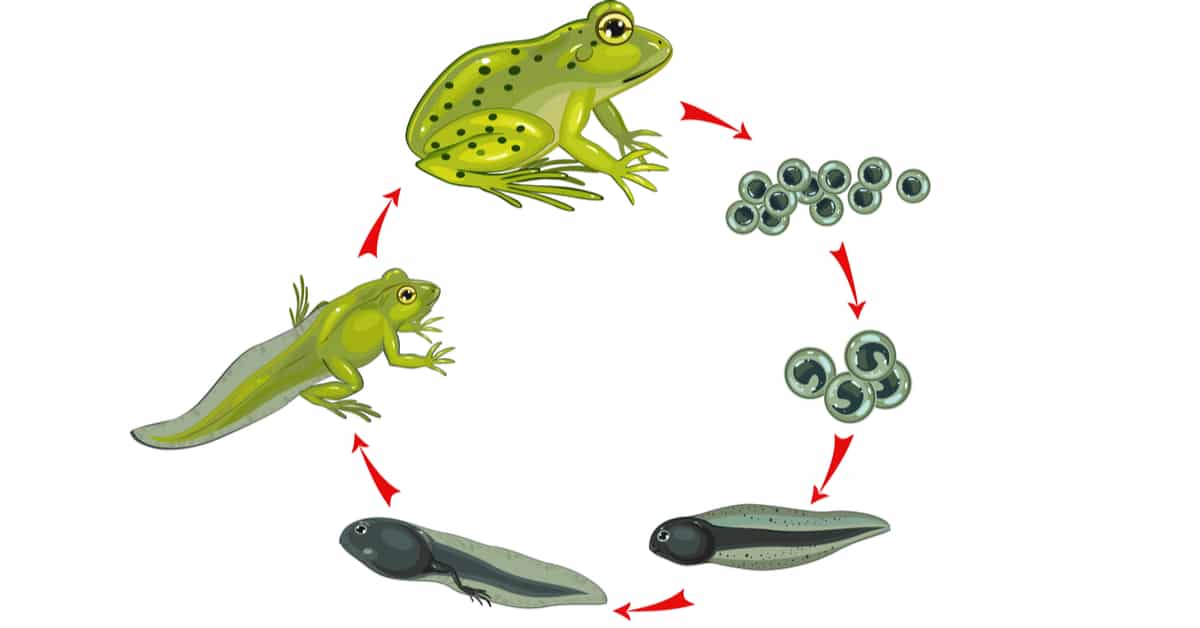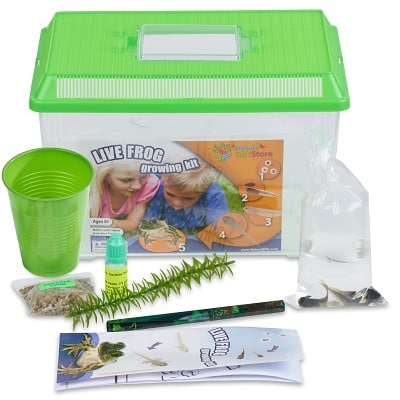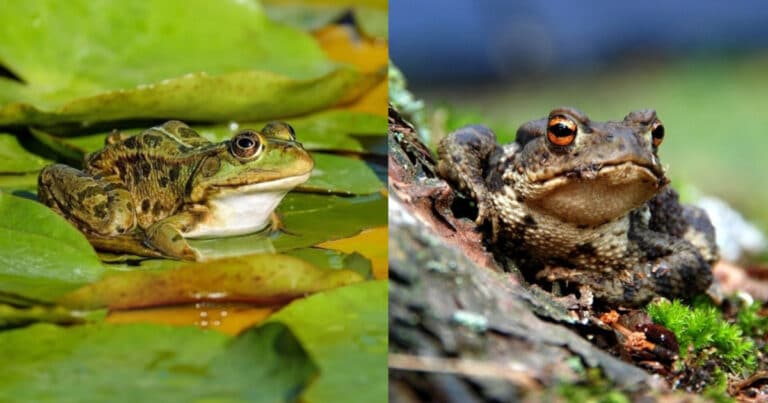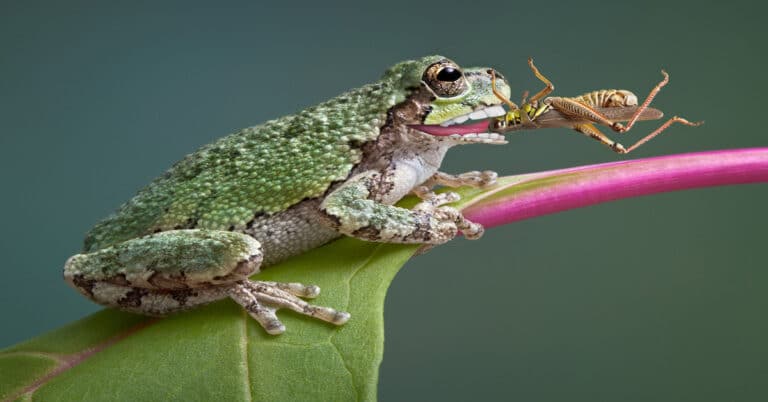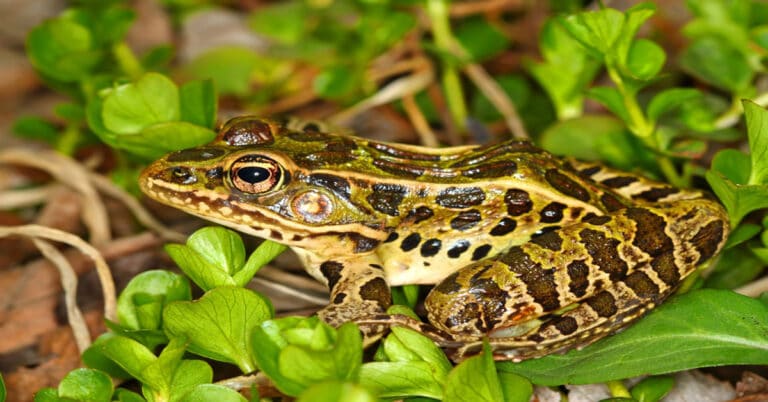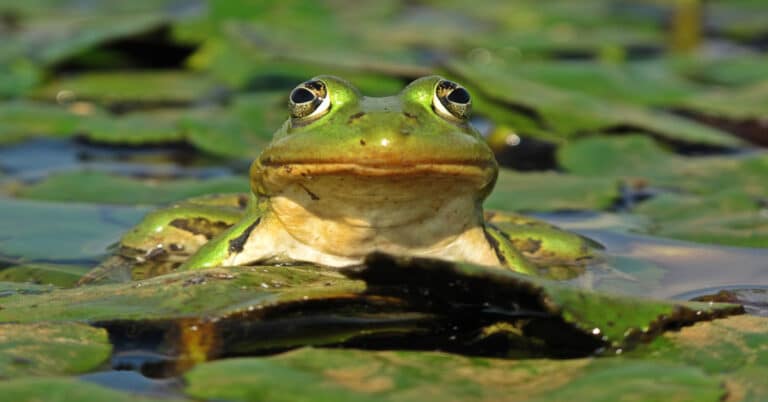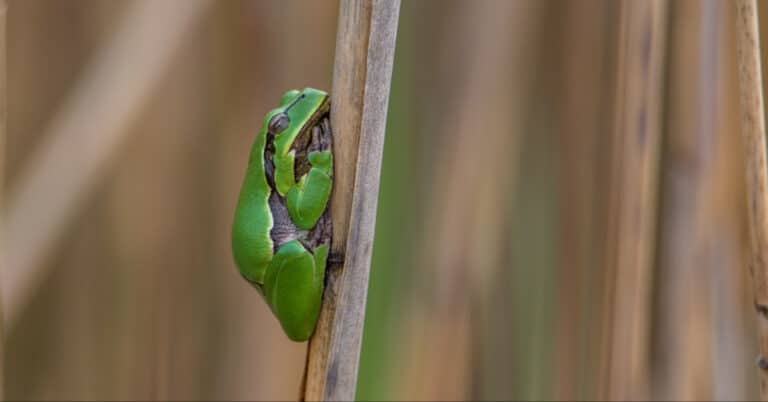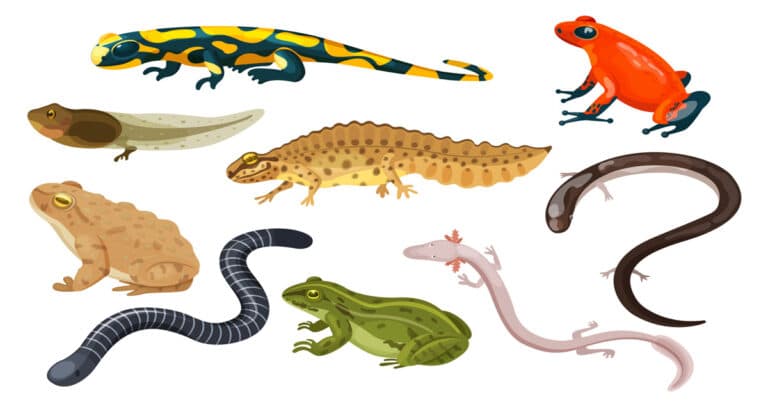Frog Life Cycle
What came first in the life cycle of a frog: the tadpole, the egg, or the frog? Let’s dive into the water to find out!
A frog’s life cycle is very different than many animals you may know of. It starts when the mommy and daddy frog fall in love and decide to have baby frogs. Sound familiar? Okay, nobody really knows if frogs fall in love, but it’s okay to think that they do.
Crooooaaaakkk, ribbit, ribbit. The first step in the life cycle of a frog is the baby-frog-making process. You will hear the male frog sounding his mating call to attract a female — typically at night. When the female is full of eggs, she will be ready to mate. She will go find the male that she feels is most suitable based on the sound of the mating call. The ladies can be picky and may walk around for several nights before settling on a male. They usually find the lower-pitched calls more attractive and will choose the male with the deepest voice.
Mom and Dad frog will then mate, usually in the water. Some species may mate in a tree. You will know when this is happening when you see the dad frog hugging the mom frog from behind her. This will look like the female is giving the male a piggyback ride. The dad frog will lay on top of the mom frog and wrap his front legs around her body. He will hug her around the waist or under the arms usually for several days. The time varies depending on the frog and can last anywhere from a few seconds to many months depending on the species. This “hug” is called amplexus.
During amplexus, some male frogs find it difficult to stay on top of the female, as they can be much smaller than their mates. They can actually make and secrete a sticky paste to somewhat glue themselves to the females. This literally turns into a clingy relationship.
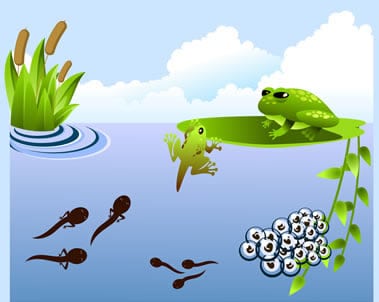
Spawning
While mommy and daddy frog are hugging, the mom frog will lay a bunch of eggs for the dad frog to fertilize. Unlike chicken and other animals’ eggs, frog eggs are fertilized by male frogs after they are laid and outside of the female frog’s body. This is called spawning. Spawning is the very beginning of the life cycle of a frog.
After the mom and dad frog have finished spawning, the male and sometimes also the female will leave. For males and some females, this is the last they see of their offspring. However; in many breeds of frogs, the female will stick around and wait for the babies to hatch. She may even make a nest or put the eggs in pouches on her skin to help protect them. In these cases, the female may even care for her young by sticking around and watching the tadpoles as they grow.
The Frog Eggs
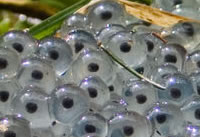
The mommy frog will lay many, many eggs. She will usually lay thousands. Crazy, right? The reason they lay so many eggs is because a large percentage of the eggs will not hatch. This is typical in many reptile and amphibian species. Some of the eggs will be eaten by other small animals and birds, while some of them won’t even become fertilized. Other eggs might become dried up in the sun or even crack in the water. The eggs that survive will hatch after about 7 to 9 days. This begins the next life stage in the life cycle of a frog.
The Tadpole
When frog eggs hatch they don’t come out as frogs right away. The new creatures will start out as tiny little fish-like swimmers called tadpoles. The only parts to the baby tadpole are the gills, the tail, and the mouth. In the beginning, a tadpole will eat the egg yolk that is still left in its belly. In this part of the life cycle of the frog, the egg yolk provides the essential nutrition a developing tadpole needs. After about 7 days of constant development, the tadpole will begin to swim around on its own and eat algae from the top of the water.
How does the tadpole live under the water, but its parents live on land? The tadpole is able to breathe in the water because frogs are amphibians. As juveniles, amphibians live in water. As adults, they live and breathe on land. This is just another cool fact about the life cycle of a frog. Other amphibians include newts and salamanders. Amphibians are often confused with reptiles, which are also cold-blooded. Reptiles live their entire life on land.
Tadpole Development
About four weeks into the tadpole’s part of the frog life cycle, the young tadpole will begin to grow teeth and skin over the gills. The tadpole will begin to become social and swim in schools like fish. A “school” is a large group of fish who swim together. Who knows, maybe the are learning as they go, just like human school!
After 6 to 9 weeks in the tadpole’s development in the frog life cycle, it will begin to grow longer and develop a more obvious head and back legs. At the end of the 9 weeks, the tadpole will look more like a frog than a fish. You will still notice that the animal has a long tail. The tadpole will become a carnivore, or meat-eater. Small insects will make up its diet.
In areas of the world that have cold winter months, the tadpoles part in the frog life cycle take longer. It may even talk all winter long to complete. This is partially because they are cold-blooded, meaning their body temperature it the same as it is outside. Their body processes move much slower when it is cold! This also happens in area of high altitudes because of the cold there as well.
Fun fact: tadpoles are also know as polliwogs!
Frog Metamorphosis
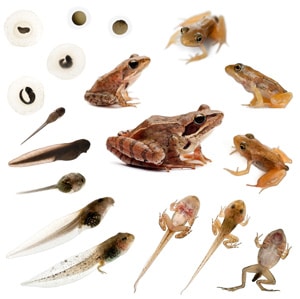
From 9 to about 12 weeks, frog metamorphosis starts to really take shape. The tadpole that looks like an itty bitty frog but with a long tail, called a froglet. The froglet will lose most of its tail, grow a long, sticky frog tongue, and really start to look like a little baby frog. The tail is absorbed by the new frog and is actually used as a source of protein to power its growing body!
The froglet will begin to live on land and will breathe though its skin and its new lungs as it transitions into an adult frog. The whole frog metamorphous is completed after about 16 weeks when the frog becomes an adult. At this point, the frog is only breathing through its lungs. The froglet will live on land for up to three years before it returns back to the water to find a mate and create new babies of its own.
Diagram of Frog Life Cycle
If you wanted to draw a diagram of frog life cycle, you might pencil in a circle to begin with. The circle will represent the egg. You would then draw the baby tadpole. Make sure the tadpole only has gills, a tail, and a mouth. Next, add back legs and a head. Then draw front legs on the baby tadpole representing the froglet in the frog life cycle. Then draw a full grown frog making sure to leave off the tail. You are not done yet! Draw an arrow that points back to the eggs. Life cycles are continuous and keep repeating over and over. The full grown frog will find a frog to love and to make more baby frogs with and begin the life cycle of a frog all over again. It’s the circle, the circle of life. If you know, you know.
What’s the difference in a toad and frog life cycle?
Scientifically, toads are frogs. Toads are just called a categorized different because they look a little different. However, they are all part of the frog family. The main difference is that a frog’s legs are a little longer and they hop to get where they need to go. Toads mostly crawl with a few hops in between. A toad’s skin is also more resistant to moisture. Because of this, toads can live in drier climates than frogs. You will not find a toad in a rainforest; you will also not find a frog in the desert.
What the difference is between a toad life cycle and the frog life cycle? It is two things: the way that the eggs are laid and the way that the skin develops. The frog eggs are laid in clumps and toad eggs are laid out in strands or lines. Both animals go through a tadpole stage and complete metamorphosis. The skin of a frog will turn slimy and the skin of a toad will develop into warty skin. This is why many people think that toads can give you warts. It is just as likely a toad will give you warts as kissing a frog turns it into a prince. Don’t want to take my word for it? Go ahead and try!
You can purchase a Tadpole to Frog Kit here or by clicking the image below.
Grow a Frog — Which is first? Egg, frog, tadpole?
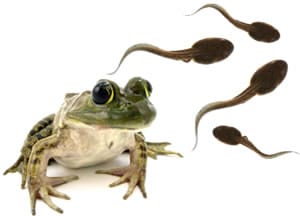
Remember the question we started the frog life cycle journey with. Which came first: the egg, the frog, or the tadpole? If you were going to grow a frog, where would you start? Would you start with a tadpole or with an egg? I bet you said egg.
A key point to remember is that most of the eggs won’t live. How would you know that you have a living egg? If you started with a tadpole it might give you better luck when you are trying to grow a frog. What do you think? Maybe you should start with a mommy and a daddy frog? If you did that, then you might grow a hundred frogs and they would take over your whole room! Your walls would turn green and their croaking would become your nightly lullaby. Okay, that’s another story for another day! My advice: start with a tadpole and you will be able to watch the whole, very cool, frog metamorphosis.
Download our free frog life cycle coloring page here!
You can also find out about the butterfly life cycle, dragonfly life cycle and ladybug life cycle and more information across Learn About Nature.
Life Cycle Of A Frog Index
- Diagram of Frog Anatomy
- All About Bullfrogs
- The Difference Between Frogs and Toads
- Fun Frog Facts
- Kiss a Frog and Other Frog Myths
- What Do Frogs Eat and What Eats Frogs?
- Do Frogs Have Teeth?
- Where do frogs live?
- Why are Frogs So Many Colors?
- What Are Amphibians?
- Frog Coloring Pages
Different Types of Frogs
- Red Eyed Tree Frog
- Whites Tree Frog
- Pacman Frog
- Golden Tree Frog
- Tomato Frog
- Fire Bellied Toad
- Tree Frog
- Cuban Tree Frog
- American Bull Frog
- Green Tree Frogs
- Leopard Frog
- Wood Frog

Having discovered a fondness for insects while pursuing her degree in Biology, Randi Jones was quite bugged to know that people usually dismissed these little creatures as “creepy-crawlies”.

